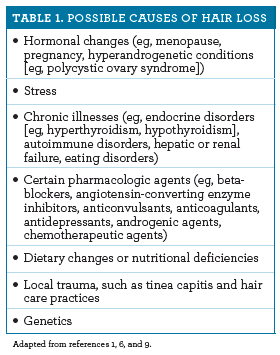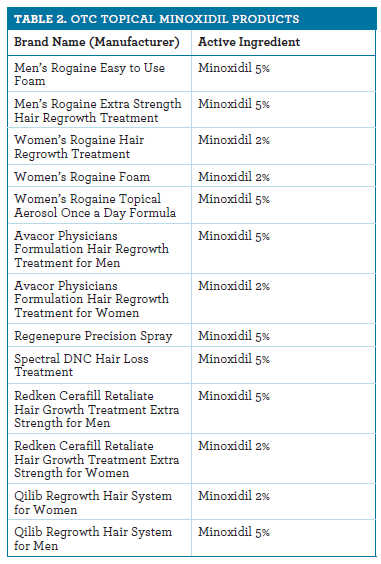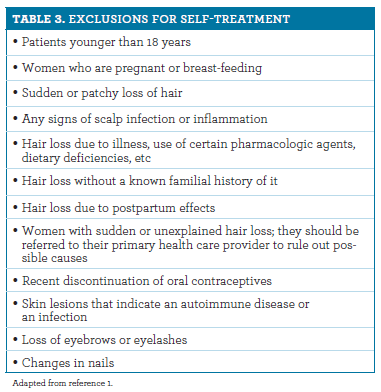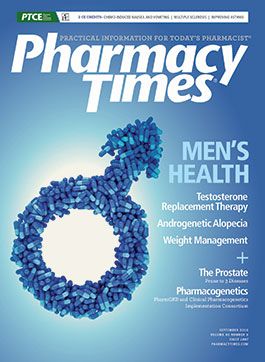Publication
Article
Pharmacy Times
Androgenetic Alopecia: OTC Products for Treatment
Author(s):
Annually, individuals spend an estimated $3.5 billion on hair loss products and procedures marketed to promote the restoration of hair growth.
Annually, individuals spend an estimated $3.5 billion on hair loss products and procedures marketed to promote the restoration of hair growth. Pharmacists are in a pivotal position to educate patients both about pharmacologic agents associated with hair loss and other causes of hair loss (Table 11,6,9), to guide patients in the proper selection of products marketed to treat hair loss (Table 2), and to direct patients to seek further medical care for hair loss when warranted.1

According to the American Academy of Dermatology, significant or abnormal hair loss, also known as alopecia, can negatively affect an individual’s self-esteem and cause feelings of embarrassment and anxiety.2 There are several types of hair loss, but androgenetic alopecia (AGA), also referred to as pattern hereditary hair loss, is the most prevalent type, affecting men and women.1-7 AGA is characterized by gradual hair loss from the scalp in a distinctive pattern and is classified as an androgen-dependent hereditary disorder in which dihydrotestosterone plays a significant role.1,5,6
According to the National Institutes of Health, an estimated 50 million men and 30 million women have some degree of AGA.1,8 AGA affects an estimated 30% of white men by 30 years of age, and the incidence increases with age, with an estimated 80% of white men and 50% of women affected by age 70.1,5 Research has identified several genetic and environmental factors that may have a role in the development of AGA. The most common causes of AGA include hormonal and hereditary factors.1,8 Moreover, AGA in men has been associated with several other medical conditions, including coronary heart disease and enlargement of the prostate.1,8 Additionally, prostate cancer, disorders of insulin resistance—including diabetes and obesity—and hypertension have been linked to AGA.1,8 In women, AGA is often associated with an increased risk of polycystic ovary syndrome; women suspected of having this endocrine disorder should be referred to their primary health care provider for further evaluation. A familial history of AGA also appears to be a risk factor for developing the condition.1,8
SIGNS AND SYMPTOMS OF HAIR LOSS
Those affected by AGA, unlike other types of hair loss, do not experience any signs of inflammation or scarring, and the onset of hair loss is typically gradual.1-6 In men, AGA classically begins with gradual hair loss or thinning that often appears at the temples and crown of the head.1-6 Women characteristically experience diffuse hair thinning on all areas of the scalp, but the hairline does not recede.1,6 Women presenting with signs of this type of hair loss may also exhibit severe acne, hirsutism, menstrual irregularities, and infertility due to hyperandrogenism.1,6-9 Because androgen excess in women may be an indication of more serious conditions, before using any products for hair loss, affected women should be referred for medical evaluation to identify the possible underlying cause, such as metabolic syndrome and polycystic ovary syndrome.1,6-9

OTC PRODUCTS
Currently, the only FDA-approved OTC products for treating AGA include hydroalcoholic topical solutions of minoxidil in concentrations of 2% and 5% and a 5% solvent-free foam.1 Topical minoxidil is indicated for treating baldness at the crown of the head in men and for thinning of hair at the frontoparietal region in women.1,6-9 Although the exact mechanism of action of minoxidil is unknown, it is thought to augment cutaneous blood flow directly to the hair follicles, which increase in size after treatment, and promote and maintain vascularization of hair follicles in cases of alopecia.1 Although not well proven, some individuals with other types of hair loss, such as alopecia areata, have also reported some success with the use of topical minoxidil.1 Both concentrations of topical minoxidil can be used in men and women, but the use of 5% topical minoxidil is typically recommended for use in men.1 Formulations for women are typically 2% concentrations, but oncedaily 5% formulations are also available.
There are no known drug interactions associated with the use of topical minoxidil; however, it is critical to inform patients that concurrent use of minoxidil with guanethidine may increase the incidence of orthostatic hypotension and that concurrent use of topical and oral minoxidil may augment systemic concentrations and potentiate its effects.1 The incidence of adverse effects (AEs) is low because minoxidil is absorbed through the skin in low concentrations; the most common AEs associated with the use of topical minoxidil include local itching and dryness or irritation of the scalp at the application site.1,6-9 Transient hypertrichosis is the most commonly reported AE associated with long-term use of topical minoxidil.1 Patients should be reminded to use these products as directed; their use is indicated for individuals 18 years and older.1,10 Minoxidil has a pregnancy category of C.1,10 During counseling, patients with sudden hair loss or nonpattern hair loss should always be encouraged to seek medical advice before using minoxidil products.
CONCLUSION
Prior to recommending the use of OTC hair loss products, pharmacists should ascertain if self-treatment is appropriate and if the cause of the hair loss has been identified (Table 31). Additionally, pharmacists should review a patient’s medication profile to identify pharmacologic agents or other possible factors that may be associated with increased risk of hair loss (Table 1). Patients should always be referred to their primary care physician for further evaluation if the cause of hair loss is unknown or if hair loss has an abrupt onset and/or is severe. It is important for women who experience sudden and significant hair loss to seek counsel from their physician for further evaluation and to identify causes or contributing factors.1

Patients should be counseled on the proper application of topical minoxidil and be reminded to adhere to the manufacturer recommendations.1,10,11 Patients must also understand the importance of continuously using a product to maintain regrowth of hair.1,10,11 Discontinuation of treatment results in rapid reversion to the pretreatment balding pattern.1,10,11 Patients should be advised to apply the product no more than twice daily and not to apply it to damaged or inflamed areas of the scalp.1,10,11 Topical minoxidil also should not be applied 24 hours before or after the application of hair color, a relaxer, or a perm.1,10,11
Pharmacists should inform patients that topical minoxidil may not be effective for everyone and that it is a suppressive therapy that does not cure hair loss.1 Patients should be advised that hair growth may take up to 4 months after initiation of therapy and if hair growth does not occur after 4 months of consistent use, they should discuss other possible treatments with their primary health care provider. Because hair loss may cause emotional distress and loss of self-esteem, pharmacists should try to be encouraging and supportive to affected patients.
Ms. Terrie is a clinical pharmacist and medical writer based in Haymarket, Virginia.
References
- Berry T. Hair loss. In: Krinsky D, Berardi R, Ferreri S, et al, eds. Handbook of Nonprescription Drugs. 18th ed. Washington, DC: American Pharmacists Association; 2015.
- Hair Loss. American Academy of Dermatology website. aad.org/media-resources/stats-and-facts/conditions/hair-loss. Accessed July 20, 2016.
- Alopecia. American Academy of Dermatology website. aad.org/dermatology-a-to-z/diseases-and-treatments/e---h/hair-loss. Accessed July 20, 2016.
- Varothal S, Bergfeld WF. Androgenetic alopecia: an evidence based treatment update. J Clin Dermatol. 2014;15(3):217-230. doi: 10.1007/s40257-014-0077-5.
- Alopecia. Merck Manual Online Library for Healthcare Professionals website. merck.com/mmpe/sec10/ch124/ch124b.html?qt=minoxidil&alt=sh#sec10-ch124-ch124b-975. Accessed July 20, 2016.
- Feinstein RP. Androgenetic alopeci: treatment and management. Medscape website. emedicine.medscape.com/article/1070167-treatment. Accessed July 20, 2016.
- Sinclair R, Torkamani N, Jones L. Androgenetic alopecia: new insights into the pathogenesis and mechanism of hair loss. F1000Res. 2015;4(F1000 Faculty Rev):585. doi:10.12688/f1000research.6401.1.
- Androgentic alopecia. National Institutes of Health Genetics Reference website. ghr.nlm.nih.gov/condition/androgenetic-alopecia. Accessed July 20, 2016.
- Causes of hair loss. American Hair Loss Association website. americanhairloss.org/women_hair_loss/causes_of_hair_loss.asp. Accessed July 20, 2016.
- Topical minoxidil drug information. Medscape website. reference.medscape.com/drug/rogaine-minoxidil-topical-343548. Accessed July 20, 2016.
- Rogaine [package insert] New Brunswick, NJ: Johnson & Johnson Consumer; 2016.







